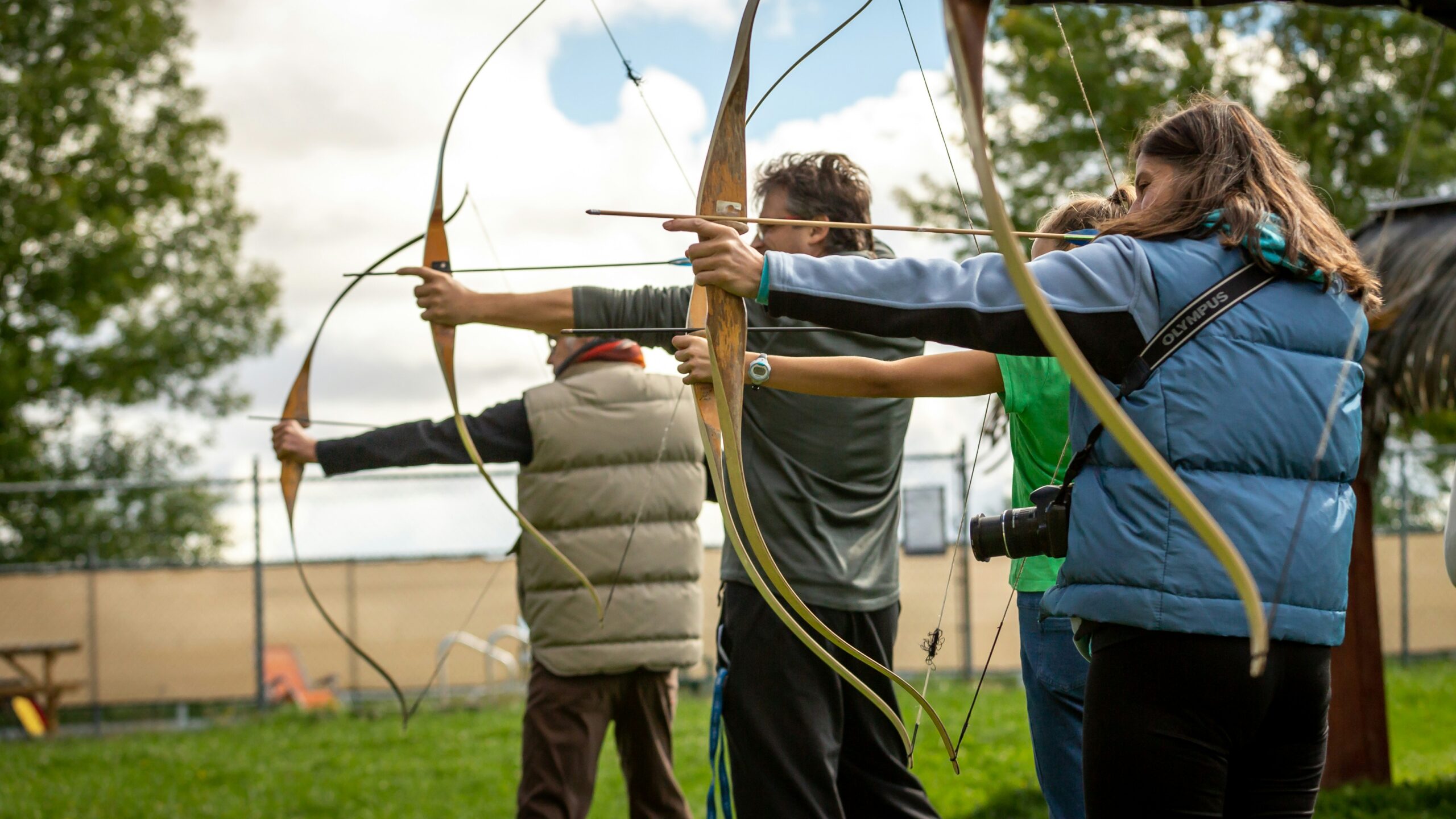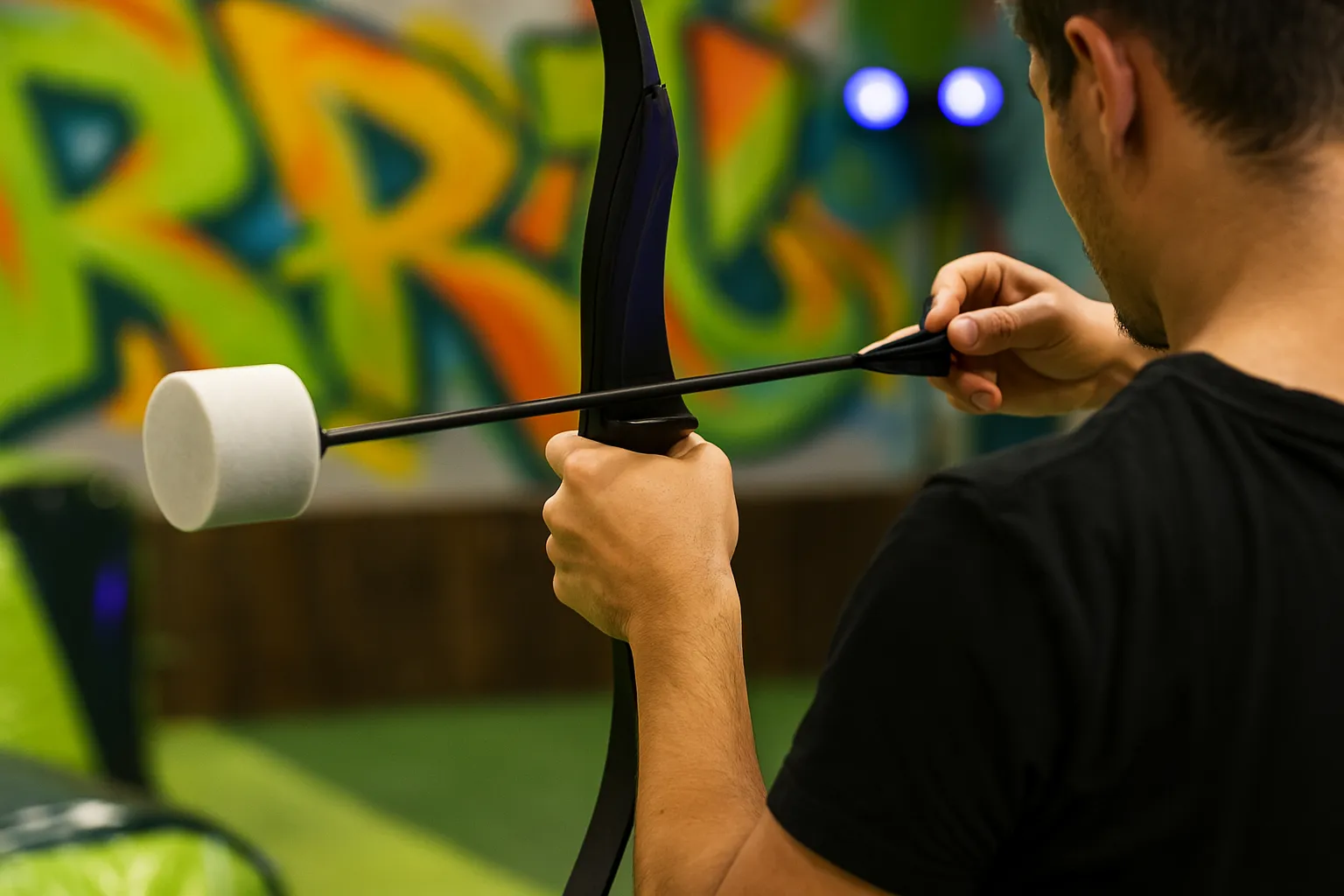Archery Arrow Tag and traditional archery may share roots, but they’ve evolved into two very different experiences. One is an adrenaline-filled group activity with foam-tipped arrows flying across team-based arenas. The other is a precise solo discipline steeped in technique and tradition. The core differences lie in the equipment, gameplay, safety requirements, and learning curves of each style. Understanding these distinctions helps players choose the experience that matches their interests, whether they’re looking for active group play or focused personal growth.
Key Takeaways
- Archery Arrow Tag uses foam-tipped arrows and light bows designed for safety and speed.
- Traditional archery relies on rigid, sharp-tipped arrows and powerful bows built for precision.
- Arrow tag emphasizes protective gear and dynamic team-based play.
- Traditional archery demands technical form, steady aim, and quiet focus.
- Each style offers unique physical demands, safety considerations, and skill progression paths.
Examining Core Equipment Distinctions in Archery Arrow Tag and Traditional Archery

Archery Arrow Tag and traditional archery differ primarily in equipment design. In arrow tag, both arrows and bows are built to maximize safety and durability. Lightweight, foam-tipped arrows help reduce injury during fast-paced play. In contrast, traditional archery uses arrows made of wood or carbon fiber with metal tips; these are designed for aerodynamic performance and precision.
Arrow Construction Variations for Safety and Performance
Arrow tag arrows are engineered for soft impacts, using foam or plastic tips that absorb energy on contact. This design contrasts with traditional arrows, which use rigid materials like aluminum or carbon fiber for greater distance and accuracy. Traditional archery arrows are built for consistent flight and penetration. Arrow tag focuses instead on cushioned tips that reduce harm during impact. This difference supports more energetic, movement-based play in arrow tag. The material distinction also affects how each arrow is stored, cleaned, and maintained. Durability needs differ, making arrow tag equipment ideal for repeat, casual use.
Bow Types and Draw Weights Suited to Each Archery Form
Arrow tag bows typically have lower draw weights and simplified mechanisms that allow quick reloads, supporting rapid, playful shooting. Traditional archery bows—including recurve, compound, and longbows—are designed for power and precision, with specific draw weight requirements for accurate, long-distance shooting in competitions or hunting. Arrow tag bows are often made of lightweight plastic or composite materials. Their tension is purposefully limited to prevent excessive force. Traditional bows, by contrast, may require advanced strength and form to manage consistently. The difference affects accessibility—arrow tag is more beginner-friendly. Both styles require proper handling, but the demands vary greatly.
Protective Gear Mandates in Archery Arrow Tag
At Brainy Actz, safety in arrow tag is enhanced by mandatory helmets, arm guards, and padded clothing, ensuring players are well-protected during fast, energetic matches. Traditional archery does not require extensive protective gear because the risk of injury remains lower due to the focus on controlled, individual shooting. Arrow tag gear is designed for frequent, mobile activity. Masks prevent facial hits during fast action. Chest pads and armguards cushion close-contact moments. Traditional archery often limits itself to finger tabs and light forearm protection. The gear difference reflects each activity’s speed, distance, and player interaction.
Target Systems Employed in Traditional Archery Versus Archery Tag Gameplay
Traditional archery relies on fixed targets with scoring rings that reward precision. In arrow tag, targets are dynamic and vary in movement, integrated into an interactive field. This system adds unpredictability and requires strategic team play. Static targets in traditional ranges prioritize stillness and accuracy. Arrow tag’s moving and human-based targets encourage quick reaction time. Each game style benefits from a different layout. Traditional targets stay uniform across matches. In contrast, arrow tag setups can be altered to change difficulty and engagement. This variability makes arrow tag more dynamic and adaptable to various player groups.
How the Purpose and Play Archery Styles Differ

The two styles differ in both purpose and gameplay. Arrow tag is an interactive, team-based game emphasizing non-lethal competition, while traditional archery is focused on individual performance measured by precision and scoring. Arrow tag is structured around movement and reaction, while traditional archery is built on stability and aim. The team format of arrow tag allows for collaboration, making it suitable for social and group settings. Traditional archery is often practiced solo or in quiet range environments. Gameplay pacing also varies—arrow tag is fast and active, whereas traditional archery is slow and deliberate.
Defining Victory Conditions in Archery Arrow Tag Matches
In arrow tag, victory is gained by hitting specific targets on opponents’ gear. The game rewards quick decisions, coordinated team strategies, and agile movements rather than pure accuracy. Matches may have multiple objectives, such as tagging all players or capturing a target zone. Points may accumulate based on successful hits or team survival. Winning depends on cooperation and field awareness. Team rotations and varied roles add replay value. Unlike individual-based sports, the outcome is collective. This format makes it ideal for groups of mixed skill levels.
Achieving Precision as the Primary Aim in Traditional Archery
Traditional archery is a solo pursuit where every shot contributes to the final score. Consistent form, steady hands, and proper technique are essential to success. The sport values accuracy over speed, with each round allowing for calm, measured performance. The smallest variation in release or aim affects scoring. Archers practice intensively to improve focus and precision. Performance is scored individually and compared across rounds. The atmosphere is structured, quiet, and focused. The entire activity centers on self-discipline and measured improvement.
Collaborative Team Strategies Unique to Archery Arrow Tag
Team strategies are key in arrow tag. At Brainy Actz, players plan offensive and defensive moves, assign roles, and work together to outsmart opponents in a fast-evolving game. Some may block, while others shoot or retrieve arrows. Strategy shifts depending on the field layout and opponent tactics. Communication is essential—teams call out plays, alert each other to threats, and coordinate flanking movements. Success depends more on collaboration than individual skill. The game’s design encourages teamwork under pressure. Rotating strategies mid-match adds challenge and variety.
Individual Marksmanship Development in Traditional Practice
Traditional archery focuses on personal improvement. Archers work on muscle memory, breathing, and consistent technique over time. Training often begins with stance and grip, advancing to anchoring and controlled release. Progress is marked through tighter groupings and higher scores. The experience is quiet and internal, often meditative. Competitions highlight each person’s ability to maintain form under pressure. There’s less reliance on external dynamics. Success reflects time, focus, and mental control. It appeals to those who enjoy precision sports.
Contrasting Safety Measures and Risk Factors

Safety measures vary significantly between the two styles due to differences in equipment, play context, and pace. Archery arrow tag focuses on high-energy, group-based movement, while traditional archery involves slower, isolated shooting. Each environment dictates its own set of safety needs. Arrow tag introduces contact zones and obstacles, increasing motion-based hazards. Traditional ranges control risk by restricting movement and emphasizing structured behavior.
Built-in Safety Features of Archery Arrow Tag Equipment
Arrow tag equipment is designed with safety in mind. Foam-tipped arrows, lightweight bows, and designated play areas with soft surfaces help minimize injury. Helmets and pads are mandatory, especially in indoor matches. Staff supervise every game and enforce strict rules. Arrows are designed to bend rather than pierce. Bows are calibrated for low draw weights to limit force. Players are separated by roles and movement zones. These layered features make arrow tag safe for all ages.
Range Safety Rules Essential for Traditional Archery
Traditional archery relies on strict range protocols. Clear shooting lines, safety nets, and supervised sessions ensure proper behavior. Only one archer typically shoots at a time. Archers are spaced evenly to prevent contact. Shooting ceases on command if a hazard is detected. Targets are positioned at set distances for safe retrieval. Archers are taught to hold until lanes are cleared. These structured processes allow solo practice to continue with minimal risk.
Common Injury Potentials and How They Differ
In arrow tag, injuries are rare and generally minor, thanks to the forgiving equipment and protective gear. Players may experience bruises or bumps from falls or missteps. Traditional archery risks include repetitive strain or shoulder injuries from improper form. Improper string release may cause forearm slaps. Good form and warmups help prevent these issues. Arrow tag risks are motion-based; traditional archery risks are form-based. The type of movement in each sport creates its own safety concerns.
Supervision and Instruction Variances
Arrow tag games require active supervision from certified instructors to enforce safety rules. Referees monitor each player’s actions, stop play for violations, and guide beginners. Traditional archery, while supervised for newcomers, allows experienced archers more independence. Coaches often focus on technique correction during lessons. Less oversight is needed once good habits are established. The difference reflects the dynamic nature of arrow tag versus the routine of solo shooting.
Analyzing Skill Requirements and Learning Curves

Arrow tag emphasizes basic movement, reaction, and coordination. Traditional archery requires controlled, repetitive technique. One is centered on agility; the other on precision. Each style attracts players based on preferred pace and learning structure. Skills grow through repetition, coaching, and gameplay exposure. Players often find one more intuitive than the other. The time to feel confident varies by discipline. Physical and mental demands help guide that process.
Foundational Skills for Participating in Archery Arrow Tag
In arrow tag, basic skills like quick reflexes, basic aiming, and spatial awareness are essential. Training sessions focus on grip, target practice with foam arrows, and understanding team tactics. Players also learn how to move safely between obstacles and retrieve arrows. Rules encourage movement over pinpoint accuracy. Strategy plays a larger role than form. These elements are easy to pick up with brief instruction. Most beginners adjust after a few rounds. The game is designed to welcome players of all levels.
Advanced Techniques for Mastering Traditional Archery
Traditional archery demands advanced techniques such as maintaining a consistent draw, precise release, and proper anchoring. Archers train rigorously to develop muscle memory and adjust to conditions like wind or lighting. Form breakdowns are easy to identify in scoring patterns. Precision in posture and breathing are necessary. Coaching often involves drills and video analysis. It takes time to build consistency across distances. Scoring depends on millimeter-level control. Mastery is a gradual process requiring regular practice.
Physical Fitness Demands for Each Activity
Arrow tag requires cardiovascular endurance and agility due to its fast-paced, mobile nature. Quick sprints, crouching, and directional shifts are common. Traditional archery demands isolated muscle strength, particularly in the arms, shoulders, and core, for controlled, repeated shooting. Holding tension during draw and release engages specific muscles. Both sports benefit from conditioning, though in different ways. Arrow tag leans on full-body movement. Traditional archery emphasizes stillness and stability.
Accessibility for Beginners in Both Archery Forms
At Brainy Actz, arrow tag is marketed as a fun, accessible sport perfect for groups and team-building events. Its simplified equipment and safety features lower entry barriers. Players can learn rules quickly and begin immediately. Traditional archery may be more challenging initially due to its technical demands, but introductory classes and coaching make it attainable for motivated beginners. Starting costs and time investment vary. Arrow tag favors low-prep play. Traditional archery rewards focused learners.
Frequently Asked Questions
How does archery arrow tag ensure player safety during gameplay?
At Brainy Actz, player safety is a top priority in every archery arrow tag session. We use foam-tipped arrows, low-draw-weight bows, and mandatory protective gear like masks and armguards to minimize impact risks. Our staff supervises each game closely, guiding players through safety briefings and enforcing rules to keep the experience fun, fast-paced, and injury-free.
What skills are essential for beginners in traditional archery?
Beginners in traditional archery focus on developing steady aim, consistent draw technique, proper anchoring, and controlled breathing. These foundational skills help improve precision and form over time. While Brainy Actz specializes in archery tag, we understand that traditional archery emphasizes quiet concentration and muscle memory, making it ideal for those who enjoy focused, individual progress.
Can archery arrow tag be played indoors and outdoors?
Yes, archery arrow tag is highly versatile and can be played both indoors and outdoors. At Brainy Actz, our arenas are adaptable to various spaces, whether it’s a structured indoor layout or a dynamic outdoor setup. This flexibility allows for exciting gameplay in different environments, customized to events, group sizes, and safety preferences.
What equipment differences define the two archery styles?
Traditional archery uses rigid arrows with metal tips, high-draw-weight bows, and fixed targets designed for precision. Archery arrow tag, on the other hand, uses foam-tipped arrows, lightweight bows, and movable game targets. At Brainy Actz, our arrow tag gear is designed for quick play, safety, and accessibility, creating a more action-driven, team-oriented experience.
How do team strategies differ from individual targets in archery competitions?
In traditional archery, players aim for static targets with individual scoring based on accuracy. Archery arrow tag, as played at Brainy Actz, relies on team coordination, where players work together to tag opponents, control zones, and achieve dynamic objectives. Strategy, communication, and movement play a much larger role than solo precision.
Conclusion
Both archery styles offer compelling experiences for different audiences. Archery Arrow Tag caters to players seeking movement, social interaction, and a fast-paced game, using equipment that prioritizes safety and flexibility. Traditional archery provides a more methodical, individual journey rooted in discipline and accuracy, with gear optimized for stability and control. By examining the equipment and gameplay setups, it becomes clear how these two sports serve different purposes. Whether you’re dodging foam arrows in an arena or drawing back for a bullseye on a silent range, each form of archery delivers its own type of challenge and reward.

